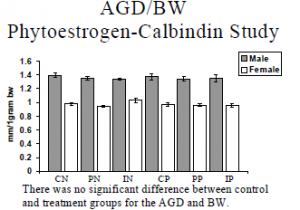Heather Taylor and Dr. Edwin Lephart, Zoology
Introduction:
Calcium plays a major part in muscle contraction, bone growth, but especially in central nervous system (CNS) development and function. Calcium participates in neuronal growth and degeneration. For example, the CNS depends on calcium during the development of neuronal cytoskeletal structures and synapse formation. When there is an excess of calcium, it disrupts the formation and the essential synapses or connections and they fail to form correctly.
Calbindin D-28k is a calcium binding protein that is found in the brain. It is linked with cell proliferation and programed cell death. Calbindin helps to regulate the amount of calcium in neurons. When there is an influx of calcium, calbindin sequesters the intracellular calcium to prevent over absorption within the neurons. An over-abundance of calcium leads to cell degeneration and eventually cell death. At the same time, calbindin buffers intracellular calcium levels in neurons at correct levels for proper function. Brain sites that are exposed to toxic amounts of calcium where calcium-binding proteins are present experience less neurodegeneration than in areas where these proteins are less abundant. It has previously been published by our lab that calbindin is regulated by glucocorticoids (hormones produced in response to stress), but it are also modulated by other hormones such as androgens and estrogens.(1,2)
Phytoestrogens are plant hormones that resemble and mimic the actions and effects of steroidal estrogens that naturally occur in the body. Phytoestrogens are found most abundantly in soy products and are found in high concentrations in soy based human infant formulas (Prosobee and Isomil were administered in this study). It is not known how high doses of phytoestrogens will affect human development. It is especially important to study the affects of phytoestrogens in HIF on neuronal development because CNS development is critical at age where infants would be receiving these high doses of phytoestrogens.
Overview of Study:
Adult female Sprague-Dawley rats were randomly assigned to six different treatment groups (n=3). On the day of insemination (gestational day 0), the rats were started on the specific rat chow diets. For the last four groups mentioned, treatments of 50 ml of human infant soy formula per day were started on gestational day (GD) 12 and administered once daily until GD 20. The phytoestrogens were administered in the following ways:
The tissue was collected on GD20 following the final treatment, and the anogenital distance and birth weight were recorded. Brain tissue was then collected from the medial basal hypothalamic (MBH) and amygdala (AMY) areas. The calbindin levels were quantified by Western Blot analysis. This is a research method of protein detection using antibodies specific for calbindin, followed by quantification using imaging analysis.
Results:
There were no significant differences between groups for the anogenital distance, birth weight,
and calbindin levels.
Significance:
This study showed that administering human infant soy formula to infants during their critical CNS developmental stages does not significantly alter the calbindin levels in the brain. This study tends to support the idea that human infant soy formulas are not detrimental to the regulation of calbindin levels during brain development.
References
- Lephart, ED, Development Brain Research 96: 281-2884 1996
- Lephart, ED, Watson, MA, Jacobson, NA, Rhees, RW, Ladle, DR, Dev Brain Research 100:117-120, 1997




